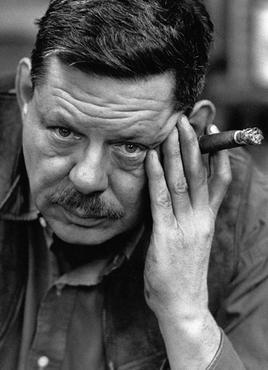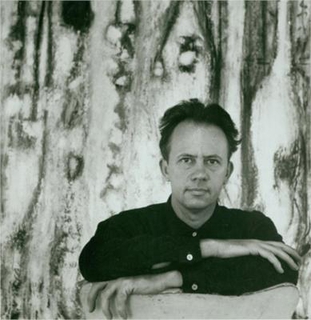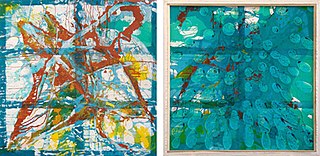Related Research Articles

Max Ernst was a German painter, sculptor, printmaker, graphic artist, and poet. A prolific artist, Ernst was a primary pioneer of the Dada movement and Surrealism in Europe. He had no formal artistic training, but his experimental attitude toward the making of art resulted in his invention of frottage—a technique that uses pencil rubbings of textured objects and relief surfaces to create images—and grattage, an analogous technique in which paint is scraped across canvas to reveal the imprints of the objects placed beneath. Ernst is noted for his unconventional drawing methods as well as for creating novels and pamphlets using the method of collages. He served as a soldier for four years during World War I, and this experience left him shocked, traumatised and critical of the modern world. During World War II he was designated an "undesirable foreigner" while living in France.
Abstract expressionism in the United States emerged as a distinct art movement in the immediate aftermath of World War II and gained mainstream acceptance in the 1950s, a shift from the American social realism of the 1930s influenced by the Great Depression and Mexican muralists. The term was first applied to American art in 1946 by the art critic Robert Coates. Key figures in the New York School, which was the epicenter of this movement, included such artists as Arshile Gorky, Jackson Pollock, Franz Kline, Mark Rothko, Norman Lewis, Willem de Kooning, Adolph Gottlieb, Clyfford Still, Robert Motherwell and Theodoros Stamos among others.

James Albert Rosenquist was an American artist and one of the proponents of the pop art movement. Drawing from his background working in sign painting, Rosenquist's pieces often explored the role of advertising and consumer culture in art and society, utilizing techniques he learned making commercial art to depict popular cultural icons and mundane everyday objects. While his works have often been compared to those from other key figures of the pop art movement, such as Andy Warhol and Roy Lichtenstein, Rosenquist's pieces were unique in the way that they often employed elements of surrealism using fragments of advertisements and cultural imagery to emphasize the overwhelming nature of ads. He was a 2001 inductee into the Florida Artists Hall of Fame.
Karole Armitage is an American dancer and choreographer currently based in New York City. She is artistic director of Armitage Gone! Dance, a contemporary dance company that performs several times annually in New York City as well as touring internationally. She was dubbed the “punk ballerina” in the 1980s. She earned a Tony nomination for her choreography of the Broadway musical Hair.

Adolph Gottlieb was an American abstract expressionist painter, sculptor and printmaker.

Edwin Parker "Cy" Twombly Jr. was an American painter, sculptor and photographer.

Roland David Smith was an influential and innovative American abstract expressionist sculptor and painter, widely known for creating large steel abstract geometric sculptures.

John Anthony Baldessari was an American conceptual artist known for his work featuring found photography and appropriated images. He lived and worked in Santa Monica and Venice, California.

Alex Katz is an American figurative artist known for his paintings, sculptures, and prints. Since 1951, Katz's work has been the subject of more than 200 solo exhibitions and nearly 500 group exhibitions throughout the United States and internationally. He is well known for his large paintings, whose bold simplicity and heightened colors are considered as precursors to Pop Art.

Don Eddy is a contemporary representational painter. He gained recognition in American art around 1970 amid a group of artists that critics and dealers identified as Photorealists or Hyperrealists, based on their work's high degree of verisimilitude and use of photography as a resource material. Critics such as Donald Kuspit have resisted such labels as superficially focused on obvious aspects of his painting while ignoring its specific sociological and conceptual bases, dialectical relationship to abstraction, and metaphysical investigations into perception and being; Kuspit wrote: "Eddy is a kind of an alchemist … [his] art transmutes the profane into the sacred—transcendentalizes the base things of everyday reality so that they seem like sacred mysteries." Eddy has worked in cycles, which treat various imagery from different formal and conceptual viewpoints, moving from detailed, formal images of automobile sections and storefront window displays in the 1970s to perceptually challenging mash-ups of still lifes and figurative/landscapes scenes in the 1980s to mysterious multi-panel paintings in his latter career. He lives in New York City with his wife, painter Leigh Behnke.

Richard Warren Pousette-Dart was an American abstract expressionist artist most recognized as a founder of the New York School of painting. His artistic output also includes drawing, sculpture, and fine-art photography.

Pat Steir is an American painter and printmaker. Her early work was loosely associated with conceptual art and minimalism, however, she is best known for her abstract dripped, splashed and poured "Waterfall" paintings, which she started in the 1980s, and for her later site-specific wall drawings.

Thomas Lawson is an artist, writer, editor, and from 1991 to 2022 was the Dean of the School of Art & Design at California Institute for the Arts. He emerged as a central figure in ideological debates at the turn of the 1980s about the viability of painting through critical essays, such as "Last Exit: Painting" (1981). He has been described as "an embedded correspondent [and] polemical editorialist" who articulated an oppositional, progressive position for representational painting from within an increasingly reactionary art and media environment. Artforum called his approach to the medium "one of the most cogent and controversial" in the 80s.

Arturo Herrera is a Venezuelan-born (1959), Berlin-based visual artist known for wide-ranging work that is rooted in the practice of collage. His colorful, often rhythmic art intertwines bits of pop iconography, gestural marks, and nonrepresentational shapes using pictorial strategies of fragmentation, repetition, effacement, and dislocation. The resulting imagery often balances between abstraction and figuration, detached from inherent narratives yet vaguely familiar. Critics suggest that this ambiguity engages memory, fantasy and a viewer's unconscious private interpretive schemes, evoking a multiplicity of references and readings. In 2020, Art in America writer Ara H. Merjian described Herrera's practice—which includes works on paper, paintings, reliefs, sculpture, public art and books—as "chameleonic as [it] is consistent," one that "breathes life into modernist collage, exploring the tensions between exactitude and spontaneity, placement and displacement."

20th-century Western painting begins with the heritage of late-19th-century painters Vincent van Gogh, Paul Cézanne, Paul Gauguin, Georges Seurat, Henri de Toulouse-Lautrec, and others who were essential for the development of modern art. At the beginning of the 20th century, Henri Matisse and several other young artists including the pre-cubist Georges Braque, André Derain, Raoul Dufy and Maurice de Vlaminck, revolutionized the Paris art world with "wild", multi-colored, expressive landscapes and figure paintings that the critics called Fauvism. Matisse's second version of The Dance signified a key point in his career and in the development of modern painting. It reflected Matisse's incipient fascination with primitive art: the intense warm color of the figures against the cool blue-green background and the rhythmical succession of the dancing nudes convey the feelings of emotional liberation and hedonism.
R. H. Quaytman is an American contemporary artist, best known for paintings on wood panels, using abstract and photographic elements in site-specific "Chapters", now numbering 35. Each chapter is guided by architectural, historical and social characteristics of the original site. Since 2008, her work has been collected by a number of modern art museums. She is also an educator and author based in Connecticut.
The Pictures Generation, 1974–1984 was an exhibition at The Metropolitan Museum of Art in New York City that ran from April 29 – August 2, 2009. The exhibition took its name from Pictures, a 1977 five person group show organized by art historian and critic Douglas Crimp (1944–2019) at New York City's Artists Space gallery. The artists exhibited from September 24 to October 29, 1977 were Troy Brauntuch, Jack Goldstein, Sherrie Levine, Robert Longo and Philip Smith.
William Leavitt is a conceptual artist known for paintings, photographs, installations, and performance works that examine "the vernacular culture of L.A. through the filter of the entertainment industry...drawing on 'stock environments' and designs of films as well as the literature of the place." A critical figure in the West Coast conceptual art movement of the late 60s, Leavitt himself has managed to maintain a low profile. "Over the last 40 years, William Leavitt has made a name for himself as an influential artist while staying so far out of fame's spotlight that his hard-to-categorize works have been all but invisible to the public," wrote the LA Times. While his work is collected by high-profile artists such as John Baldessari and Mike Kelley, Leavitt himself has eschewed celebrity.

Dona Nelson is an American painter, best known for immersive, gestural, primarily abstract works employing unorthodox materials, processes and formats to disrupt conventional notions of painting and viewership. A 2014 New Yorker review observed, "Nelson gives notice that she will do anything, short of burning down her house to bully painting into freshly spluttering eloquence." Since 2002, long before it became a more common practice, Nelson has produced free-standing, double-sided paintings that create a more complex, conscious viewing experience. According to New York Times critic Roberta Smith, Nelson has dodged the burden of a "superficially consistent style," sustained by "an adventuresome emphasis on materials" and an athletic approach to process that builds on the work of Jackson Pollock. Writers in Art in America and Artforum credit her experimentation with influencing a younger generation of painters exploring unconventional techniques with renewed interest. Discussing one of Nelson's visceral, process-driven works, curator Klaus Kertess wrote, the paint-soaked "muslin is at once the tool, the medium, and the made."
Frances Barth is an American visual artist best known for paintings situated between abstraction, landscape and mapping, and in her later career, video and narrative works. She emerged during a period in which contemporary painters sought a way forward beyond 1960s minimalism and conceptualism, producing work that combined modernist formalism, geometric abstraction, referential elements and metaphor. Critic Karen Wilkin wrote, "Barth’s paintings play a variety of spatial languages against each other, from aerial views that suggest mapping, to suggestions of perspectival space, to relentless flatness … [she] questions the very pictorial conventions she deploys, creating ambiguous imagery and equally ambiguous space that seems to shift as we look."
References
- 1 2 "David Salle". Guggenheim Collection Online.
- ↑ Wainwright, Lisa S. (29 April 2024). "David Salle: American Artist". Britannica.
- ↑ "David Salle: American Painter, Printmaker, and Stage Designer". The Art Story.
- ↑ "Bio". David Salle.
- ↑ Celant, Germano; Dennison, Lisa (2006). New York, New York: Fifty Years of Art, Architecture, Cinema, Performance, Photography and Video. Milano, Italy: Skira Editore S.p.A. p. 13.
- 1 2 3 4 5 6 7 8 Sandler, Irving (1996). Art of the Postmodern Era: From the Late 1960s to the Early 1990s. United States of America: HarperCollins Publishers, Inc. pp. 234–240.
- ↑ "The Metropolitan Museum of Art - The Pictures Generation, 1974–1984". Archived from the original on 2012-02-03.
- ↑ "4 Art Gallery Shows to See Right Now". The New York Times. 13 October 2021.
- ↑ "Salle Obscures but Encourages Meaning at Skarstedt Gallery | the East Hampton Star".
- ↑ "David Salle and Karole Armitage in Conversation with Helen Molesworth". WBEZ Chicago. 2012-03-02. Retrieved 2023-10-20.
- 1 2 Small, Zachary (2023-09-22). "A.I. Excels at Making Bad Art. Can an Artist Teach It to Create Something Good?". The New York Times. ISSN 0362-4331 . Retrieved 2023-10-20.
- ↑ Stein, Lorin (September 19, 2016). "The Quotable David Salle". The Paris Review . Retrieved September 3, 2018.
- ↑ Garner, Dwight (2016-10-18). "Review: David Salle's 'How to See,' a Painter's Guide to Looking at and Discussing Art". The New York Times. ISSN 0362-4331 . Retrieved 2019-04-24.
- ↑ Graham Thompson,American Culture in the 1980s, Edinburgh University Press, 2007, p. 67